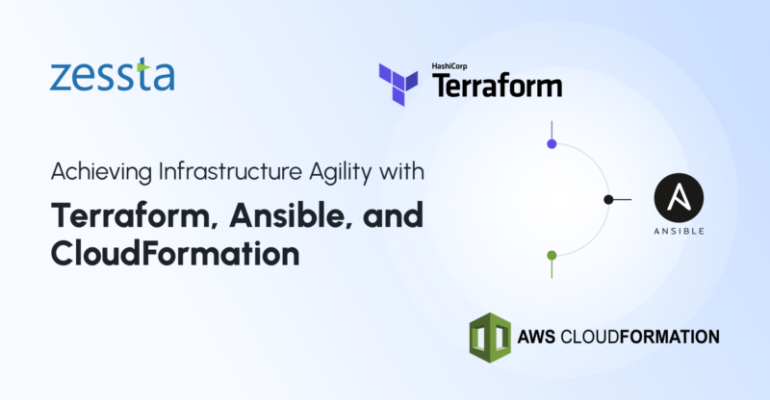Infrastructure Agility with Terraform, Ansible, and CloudFormation
Infrastructure Agility with Terraform, Ansible, and CloudFormation

Introduction:
In today’s fiercely competitive business landscape, organizations must be agile in launching new infrastructure quickly while maintaining consistency, security, and stability in their applications. To accomplish this, automation practices are crucial, and three prominent tools that facilitate this process are Terraform, Ansible, and CloudFormation. In this blog, we will delve into these tools, exploring their advanced features and use cases to help you achieve infrastructure agility.
Terraform:
Terraform is a highly popular infrastructure as a code tool that enables the definition and provisioning of cloud resources in a declarative language. It is known for its flexibility, scalability, and vendor-agnostic nature, supporting various cloud providers like AWS, Azure, Google Cloud, and more. Here’s how Terraform can help you attain infrastructure agility:
1. Complexity Management using Modules:
Simplification: Terraform’s modular design enhances code readability, comprehension, and maintainability.
Reuse: Modules can be shared across projects, regions, and environments, minimizing code duplication and saving development time.
Collaboration: Modules can be collectively maintained, promoting collaboration and knowledge sharing among developers.
2. Collaboration using Workspaces:
Isolation: Workspaces provide a controlled environment for experimenting with configurations without affecting the base infrastructure.
Collaboration: Multiple developers or teams can work simultaneously on the same infrastructure codebase within separate workspaces.
Versioning: Each workspace can be versioned independently, enabling change tracking and rollbacks.
3. Automation using Provisioners:
Automation: Provisioners automate resource installation, configuration, or customization.
Integration: Provisioners integrate external tools or services into your infrastructure codebase.
Idempotency: Provisioners ensure that only necessary changes are applied, reducing the risk of human errors and conflicts.
Ansible:
Ansible is a renowned configuration management tool that employs declarative playbooks to automate application deployment, configuration, and orchestration. Its agentless architecture and active community make it user-friendly. Here’s how Ansible contributes to infrastructure agility:
1. Flexibility using Modules:
Flexibility: Ansible’s comprehensive module library allows customization and combination for tailored automation workflows.
Integration: Modules seamlessly integrate with various cloud providers, services, and tools.
Reusability: Modules can be shared and reused across different playbooks and projects.
2. Reliability using Idempotent Execution:
Idempotent Execution: Ansible maintains infrastructure in the desired state, executing changes only when necessary, minimizing errors and conflicts.
Process Steps: Ansible follows a structured process of gathering facts, comparing states, applying changes, and reporting for thorough infrastructure management.
CloudFormation:
CloudFormation is a leading infrastructure as a code tool designed for managing AWS resources through templates. Its tight integration with AWS services simplifies complex resource orchestration. Here’s how CloudFormation aids infrastructure agility:
1. Flexibility using Nested Stacks:
Modularity: Nested stacks break down infrastructure into manageable components.
Isolation: Changes can be made within nested stacks without affecting the parent stack.
Reusability: Nested stacks are shareable and reusable across different CloudFormation templates.
2. Automation using CloudFormation Macros:
Automation: CloudFormation macros automate intricate operations like dynamic parameterization and policy validation.
Customization: Macros can be tailored to specific use cases.
Integration: Macros integrate seamlessly with external services and tools.
3. Simplification using CloudFormation StackSets:
Simplification: StackSets streamline management across multiple AWS accounts and regions in a single operation.
Automation: StackSets automate provisioning and resource management.
Control: Consistent configurations and policies are enforced across all accounts and regions.
Conclusion:
Infrastructure agility is paramount for organizations seeking competitiveness and innovation. Terraform, Ansible, and CloudFormation are potent tools that automate infrastructure deployments, simplify complexity, and enhance reliability. Leveraging their advanced features enables greater agility, flexibility, and control over your infrastructure, ensuring you stay ahead in the dynamic business landscape.